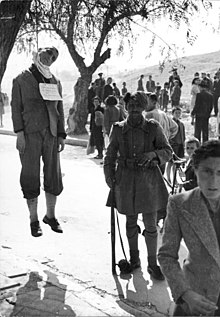Security Battalion
The security battalions ( Greek Τάγματα Ασφαλείας , Tagmata Asfalias , abbreviated Τ.Α. or TA ) were armed anti-communist associations set up by Prime Minister Ioannis Rallis in Greece , which collaborated with the Nazi occupiers from 1943 and operated in the civil war until 1949.
The security battalions were established on April 7, 1943 by the Greek collaborating government . They were mainly recruited from conscripted Greek citizens and officers from the disbanded Greek armed forces. They were under the control of the collaboration government, which in turn was under the control of the German occupying power with the commanding officer in the South Aegean or Saloniki-North Aegean. The task of the security battalions was to fight Greek resistance fighters in cooperation with the German occupation forces. The security battalions reached a strength of approx. 22,000 men, which consisted of 9 Evzones and 22 “volunteer battalions”. SS member Walter Schimana was in charge of the military high command of the security battalions .
During the occupation of Greece in World War II , the security battalions were mainly used against the communist-controlled resistance organization National Liberation Front (EAM). The security battalions were anti-communist and royalist oriented. With the fall of the Italian occupying power in September 1943, they operated with the remaining German occupation troops. Their main area of application was eastern central Greece and the Peloponnese . An expansion of the operational area to all of Greece was planned, but did not materialize during the occupation until mid / late October 1944. During the German retreat in October 1944, the security battalions were given the task of covering the German retreat by attacking Greek resistance fighters (especially ELAS , the military arm of EAM).
After the restoration of the Greek government on October 18, 1944, the security battalions were to be disarmed and disbanded. Due to the escalating unrest between ELAS and EAM on the one hand and the Greek government, the British troops and the Greek right on the other hand, their resolution was incomplete. Rather, despite the collaboration with the occupying powers of Greece, the security battalions and their members were in part taken over into the regular Greek police and later also into the army. In this function, they fought in the Greek civil war from late March 1946 to late September 1949 against the communist-controlled insurgents of the Democratic Army of Greece (DSE).
Although the Greek government-in-exile declared any membership in the security battalions to be a criminal offense, the Greek courts in the trials against collaborators such as former Prime Minister Georgios Tsolakoglou and other ministers of the collaboration government ruled that the formation and membership in the security battalions was not a criminal offense in itself.
See also
swell
- Tasos Vournas, History of Modern and Contemporary Greece (Ιστορία της Νεώτερης και Σύγχρονης Ελλάδας), Vol. 3 and 4. Patakis Verlag, Athens, 2005. ISBN 960-600-526-7 and ISBN 960-600-527-5
- Giannis Douatzis, The Security Battalion Members (Οι Ταγματασφαλίτες). Tolidis brothers, 1983
- Mark Mazower , Inside Hitler's Greece , Greek edition. Patakis Verlag, 1993.
Individual evidence
- ^ Mark Mazower: Three Forms of Political Justice: Greece, 1944-1945. Mark Mazower (Ed.). After the War Was Over: Reconstructing the Family, Nation, and State in Greece, 1943-1960. Princeton University Press, 2000. p. 34. ISBN 0-691-05842-3
